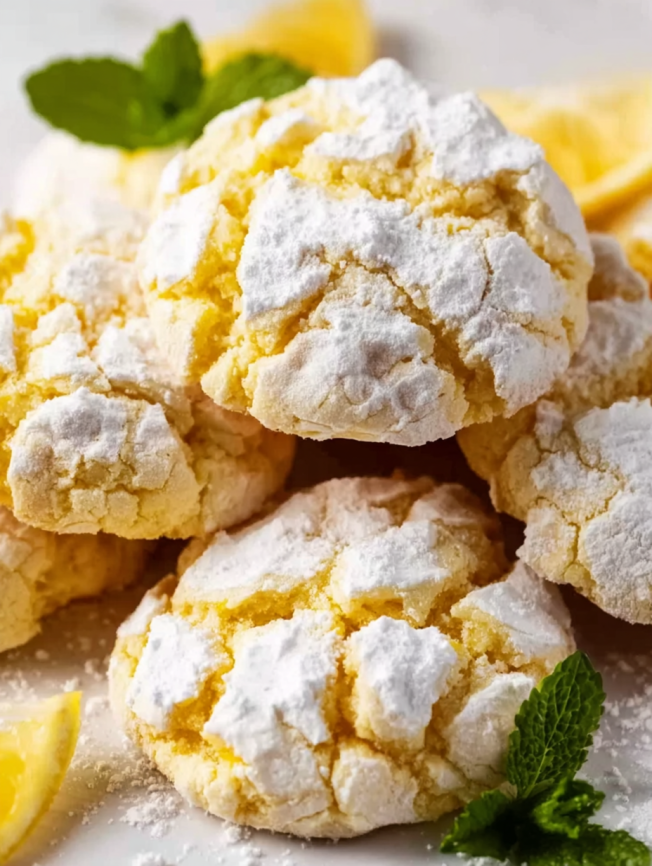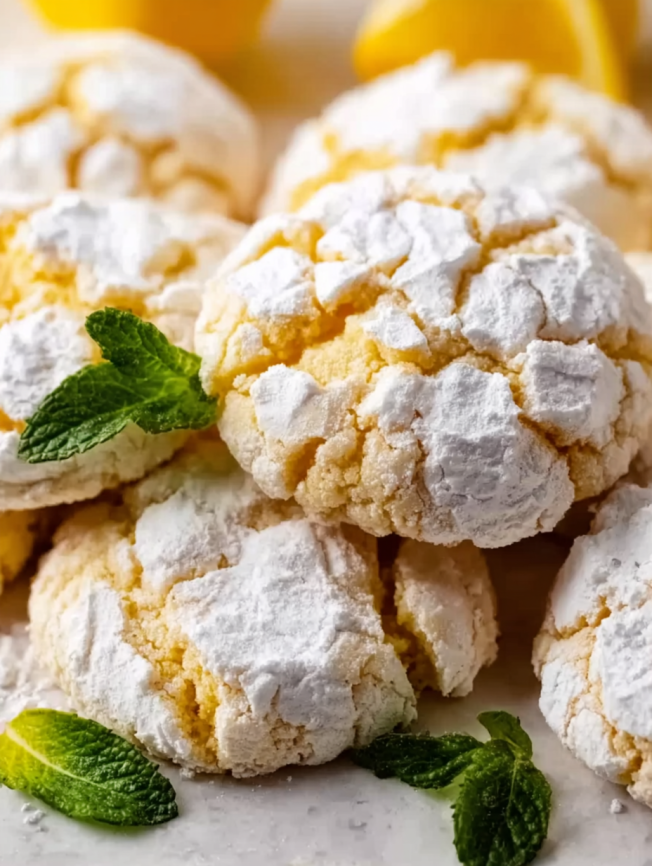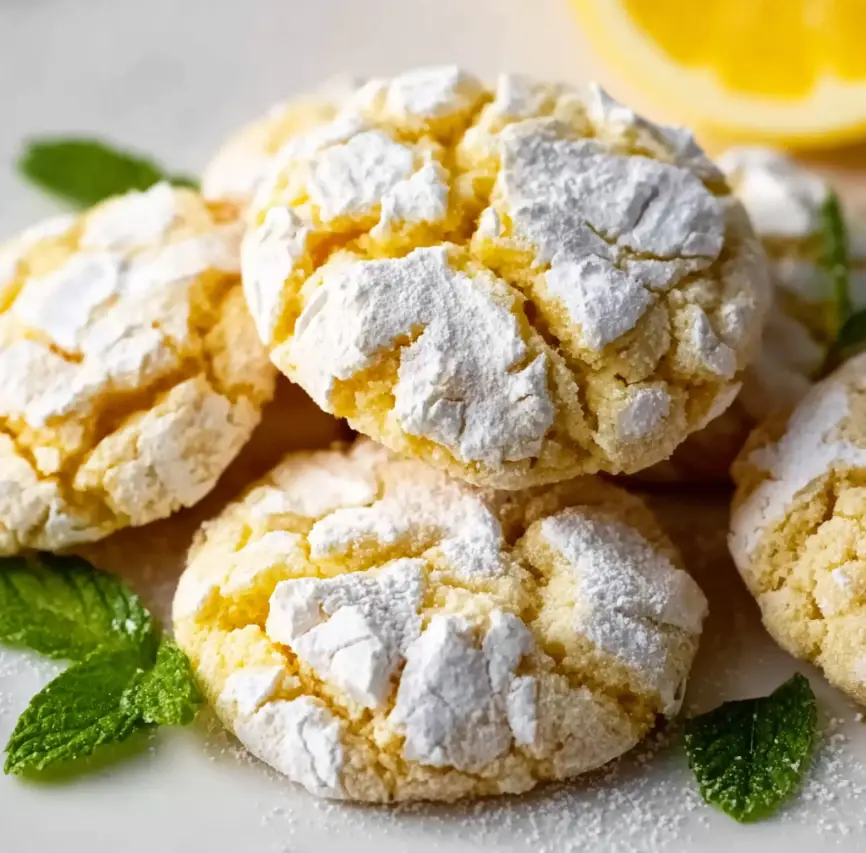There’s something magical about the moment you bite into a perfectly crinkled cookie, watching that powdered sugar coating crack to reveal the tender, lemony goodness inside. My love affair with these lemon crinkle cookies began on a particularly gray winter day when I was craving something bright and cheerful. Traditional chocolate crinkles are wonderful, but sometimes your soul needs a burst of sunshine instead of chocolate richness.
After several kitchen experiments (and more than a few sticky dough disasters), I discovered that the secret to perfect lemon crinkles lies in patience—specifically, giving that dough plenty of time to chill and develop its flavors. Now, whenever I make these cookies, my kitchen fills with the most incredible citrus aroma, and I’m instantly transported to warmer, sunnier days.
Prep Time: 3 hours, 20 minutes
Cook Time: 12 minutes
Total Time: 3 hours, 35 minutes
Yield: 40 cookies
Why You’ll Fall in Love with This Recipe
Perfect Balance of Sweet and Tart
Unlike overly sweet cookies that can become cloying, these lemon crinkles strike the ideal balance between bright citrus tang and comforting sweetness. The generous amount of lemon juice and zest creates a bold flavor that’s refreshing rather than overwhelming.
Stunning Visual Appeal
When these cookies emerge from the oven, they’re absolutely gorgeous—each one looks like a little work of art with its distinctive cracked surface dusted in powdered sugar. Additionally, the contrast between the golden interior and white coating makes them perfect for special occasions or gift-giving.
Make-Ahead Friendly
Busy bakers will appreciate how well this recipe accommodates advance planning. The dough can be prepared up to three days ahead, making it an excellent choice for holiday baking or entertaining when time is precious.
Essential Ingredients
Main Cookie Components
- 2½ cups (313g) all-purpose flour (spooned and leveled)
- 1 teaspoon cornstarch (for extra tenderness)
- 1 teaspoon baking soda
- ½ teaspoon salt
- ¾ cup (170g) unsalted butter, softened to room temperature
- 1 cup + 2 tablespoons (225g) granulated sugar
- 1 large egg, at room temperature
- ¼ cup (60ml) fresh lemon juice, at room temperature
- 1 tablespoon lemon zest (packed—this is quite a bit of zest!)
- 1 teaspoon vanilla extract
For the Signature Coating
- 3 tablespoons (35g) granulated sugar (optional, for double-coating)
- 1 cup (120g) confectioners’ sugar
Step-by-Step Instructions
Preparing the Dough Foundation
Begin by whisking together the flour, cornstarch, baking soda, and salt in a medium bowl. Set this dry mixture aside while you work on the wet ingredients. This preliminary step ensures even distribution of leavening agents throughout your cookies.
Creating the Citrus Base
In a large bowl, use either a hand mixer or stand mixer fitted with a paddle attachment to beat the softened butter and granulated sugar together on medium-high speed. Continue beating for about one minute until the mixture becomes light and creamy. Next, add the egg, lemon juice, lemon zest, and vanilla extract, then beat on high speed for another minute until well combined.
Don’t worry if the mixture appears curdled at this point—this is completely normal when combining citrus juice with butter and eggs. Take a moment to scrape down the sides and bottom of the bowl to ensure everything is properly incorporated.
Bringing It All Together
Add the flour mixture to the wet ingredients and beat on low speed until just combined. The resulting dough will be thick, creamy, and notably sticky—this texture is exactly what we want for proper crinkle formation.
The Crucial Chilling Phase
Cover the dough tightly with plastic wrap and refrigerate for at least three hours, though you can chill it for up to three days. This chilling period is absolutely mandatory for several reasons: it allows the flavors to meld and intensify, prevents excessive spreading during baking, and makes the otherwise sticky dough manageable for shaping.
Preparing for Baking
Remove the cookie dough from the refrigerator. If it has chilled for longer than three hours, let it sit at room temperature for about 10 minutes to make scooping and rolling easier. Meanwhile, preheat your oven to 350°F (177°C) and line baking sheets with parchment paper or silicone baking mats.
Shaping and Coating the Cookies
Scoop the dough into portions of about one tablespoon each (approximately 20g per ball) and roll them into uniform balls. For the coating process, you have two options: you can roll directly in confectioners’ sugar, or for better coverage, first roll in granulated sugar, then roll very generously in confectioners’ sugar.
Pro tip: If you want those dramatic white cracks that make crinkle cookies so visually striking, roll each ball 2-3 times in the confectioners’ sugar. Place the coated balls three inches apart on your prepared baking sheets to allow for spreading.
Baking to Perfection
Bake the cookies for 12-13 minutes, watching for edges that appear set while centers still look soft. Here’s a professional baker’s secret: if the cookies aren’t spreading properly by the 9-minute mark, remove the baking sheet from the oven and give it 2-3 gentle taps on the counter. This technique helps initiate the spreading process that creates those beautiful cracks.
Final Steps
Allow cookies to cool on the baking sheet for five minutes before transferring to a cooling rack. The cookies will deflate slightly as they cool, which is perfectly normal and contributes to their tender texture.

Serving Suggestions and Pairings
Classic Presentations
These lemon crinkle cookies are delightful on their own, but they truly shine when paired with complementary flavors and beverages. Serve them alongside a steaming cup of Earl Grey tea, where the bergamot notes enhance the citrus profile beautifully.
Creative Serving Ideas
For elegant entertaining, arrange these cookies on a tiered serving stand alternating with other citrus-themed treats like lemon bars or key lime thumbprints. The visual variety creates an impressive dessert display that guests will remember.
Consider serving them with a scoop of vanilla ice cream or lemon sorbet for a more indulgent dessert experience. The temperature contrast and textural variety make this combination particularly satisfying.
Recipe Variations to Try
Citrus Alternatives
While lemon is classic, don’t hesitate to experiment with other citrus fruits. Orange crinkles offer a sweeter, more mellow flavor, while lime creates an intensely tart and tropical variation. Meyer lemons provide a more delicate, floral citrus note that’s absolutely lovely.
Flavor Enhancements
For added complexity, try incorporating a teaspoon of fresh thyme or rosemary into the dough—herbs pair surprisingly well with lemon. Alternatively, add a quarter teaspoon of cardamom for a subtle warmth that complements the bright citrus beautifully.
Texture Modifications
If you enjoy a bit of crunch, fold in finely chopped candied lemon peel or toasted almonds. These additions provide textural interest without overwhelming the delicate crumb structure.
Make-Ahead Tips and Storage
Advance Preparation Options
The beauty of this recipe lies in its flexibility for advance preparation. Cookie dough can be made and chilled for up to three days, making it perfect for busy holiday schedules or planned entertaining.
For longer-term storage, shape the dough into balls (without the sugar coating) and freeze them for up to three months. When ready to bake, simply thaw the dough balls at room temperature for at least 30 minutes, then proceed with the sugar coating and baking process.
Storing Finished Cookies
Properly stored cookies maintain their quality for up to one week at room temperature in an airtight container. For optimal freshness, place parchment paper between layers to prevent sticking and maintain that beautiful powdered sugar coating.
Baked cookies also freeze exceptionally well for up to three months. Thaw them at room temperature for the best texture and appearance.
Important Notes for Success
Understanding the Sugar Ratio
The slightly unusual amount of granulated sugar (1 cup plus 2 tablespoons) isn’t arbitrary—this extra sweetness is necessary to balance the tartness from the generous amount of lemon juice. Reducing the sugar will result in cookies that taste overly sour.
Cornstarch’s Role
While cornstarch isn’t absolutely essential, it contributes to the cookies’ tender, soft texture by inhibiting gluten development. If you don’t have cornstarch on hand, the cookies will still be delicious, though slightly less tender.
Lemon Selection and Preparation
Fresh lemons typically yield the best flavor, and you’ll usually need 1-2 large lemons to obtain both the required juice and zest. When zesting, be sure to avoid the bitter white pith beneath the colorful outer layer.

Frequently Asked Questions
Q: Why is my cookie dough so sticky and difficult to handle? A: This stickiness is completely normal and expected! The high moisture content from the lemon juice creates a sticky dough that requires chilling to become manageable. Never add extra flour to compensate, as this will result in dry, tough cookies.
Q: Can I use bottled lemon juice instead of fresh? A: While fresh lemon juice provides the best flavor, bottled juice can be substituted in equal amounts. However, the flavor will be slightly less bright and complex than with freshly squeezed lemons.
Q: My cookies didn’t crack as much as expected. What went wrong? A: Several factors affect cracking: insufficient chilling time, dough that’s too warm when shaped, or not enough confectioners’ sugar coating. Ensure your dough is properly chilled and roll generously in powdered sugar for the best cracking effect.
Q: Why do my cookies spread too much during baking? A: Excessive spreading usually indicates that the dough wasn’t chilled long enough, the butter was too warm when mixed, or the oven temperature is too low. Make sure to chill for the full three hours and verify your oven temperature with a thermometer.
Q: Can I make these cookies smaller or larger? A: Absolutely! Just adjust the baking time accordingly. Smaller cookies (about 1/2 tablespoon of dough) will bake in 8-10 minutes, while larger ones (2 tablespoons) may need 14-16 minutes. Watch for the same visual cues regardless of size.
Q: The powdered sugar seems to disappear on some of my cookies. How can I prevent this? A: This happens when the dough is too warm or when there isn’t enough coating. Try the double-coating method: roll in granulated sugar first, then very generously in confectioners’ sugar. Make sure your dough balls are properly chilled before coating.

